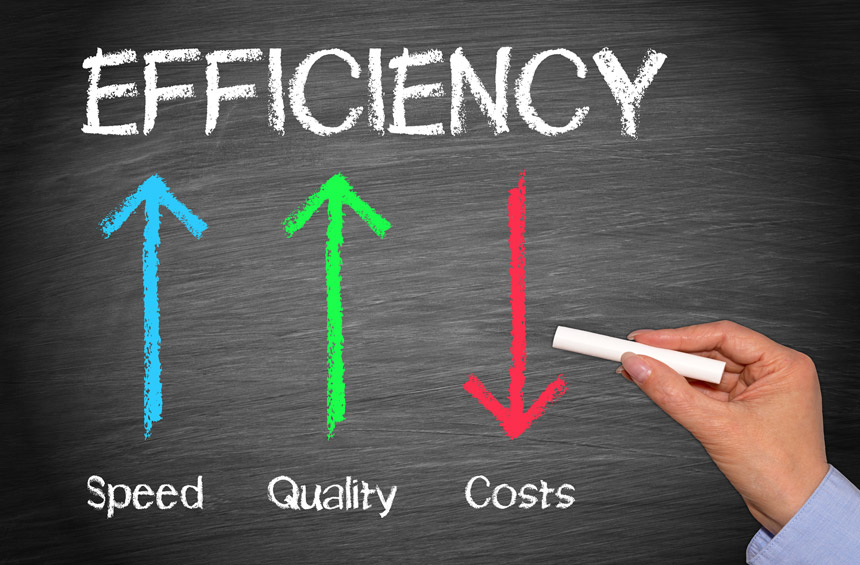Driving Efficiency Throughout Your Sales Process
By Ray Adler, CEO BTI Growth Advisors, Inc.
This blog shines a light not just on the inefficiencies in your bank’s sales efforts but also why banks are having such difficulties evolving with the times.
To better understand the difficulty banks are experiencing in their efforts to evolve and improve performance, we don’t need to look much further than a bank’s culture.
First, the cultures of most community banks breed loyalty, not necessarily high performance among employees. The typical community culture could be described as predominantly a balance of a “family culture” and a “hierarchy culture.” Characteristics of these types of cultures are:
- Friendly place to work
- Employees are like extended family
- Loyalty and tradition are important
- Cohesion and morale are priorities
- High concern for people and customers
- Teamwork, participation, and consensus are emphasized
- Procedures govern what people do
- The organization is efficiency-minded and focused on smooth, dependable operations and predictability
These are important characteristics for any company to be successful. However, a blend of family/hierarchy cultures can also create executives and employees who are too comfortable, resistant to change, fearful of making mistakes, fearful of having their performance truly evaluated, fearful of holding employees accountable and or fearful of “rocking the boat.” As a result, the status quo is maintained, and the institution is slow to adapt to the changing environment. Sound familiar?
In many financial institutions, employee performance, while important, isn’t viewed as a key driver of organizational performance such as cost of funds, net interest margin and net interest income, but rather as a necessity of operations and serving customers.
Annual performance reviews in institutions with family/hierarchy cultures are usually perfunctory rather than utilized as a powerful employee development process. While many banks provide various types of training, there is very little real emphasis on improving employee performance or holding employees accountable. Sales managers in banks typically behave more like “sales supervisors” who supervise lender production rather than behaving like sales managers and sales leaders who “manage” and “lead” their sales teams to ever-higher levels of performance.
Innovativeness and nimbleness, essential organizational qualities for any financial institution striving to remain relevant, are not typically found in organizations with strong hierarchy /family cultures. These characteristics are found in companies with “market cultures” which place a high value on market leadership and nimbleness and “adhocracy cultures” where innovation is fostered and encouraged, and acceptable execution risks are taken.
Our industry’s inability to adapt is rooted in the cultures cultivated in most banks – the proverbial family/hierarchy culture. If banks are to truly start changing with the times, your culture must start to change as well.
Looking To Less Obvious Sources of Efficiency…
Management continually looks for ways to cut expenses and streamline processes to improve the institution’s efficiency ratio and customer experience. From marketing, and data processing to headcount and administration, every expense line item is scrutinized for cost savings and opportunities to cut costs and improve efficiencies. Yet few institution’s look to the resources invested in their sales operations and ask; “Are we being as efficient and effective as possible with our shareholder’s trusted resources?” If that question were asked, and a little due diligence is done to analyze your sales efforts, I’m not sure shareholders would like the truth of what would be revealed by the inquiry.
Historically, topline production – loan and deposit growth – is one of the primary gauges of productivity, production and overall bank performance. If the commercial banking team met their overall growth goals, then the assumption is that the team is “productive” even though 80% or more of production comes from 20% or less of the commercial banking team. This surface-level perspective of production is another by-product of a family/hierarchy culture.
Your Years of Experience – As Much A Liability As An Asset Today
We’re all familiar with the adage “attitude is everything” and nowhere is there more resistance to change than within a bank’s commercial banking division. With an age range of between 45 and 60 years of age, these employees are some of the most seasoned employees in the bank. Most have a solid twenty years’ experience as lenders and relationship managers, with many having over thirty years tenure. Experience, however, can create “blind spots” where opportunities to improve are beyond the purview of the typical lender, sales manager or Chief Banking Officer. Accordingly, the willingness to even consider that there may be opportunities to improve and streamline are typically met with disdain and a roll of the eyes.
One of my favorite quotes from Tiger Woods is “No matter how good you get; you can always get better and that’s the exciting part.” Attitude is everything and if more bank employees at every level and position embraced a similar continuous improvement attitude as Tiger Woods, the pace of change would improve in banks as would the personal performance of bank employees. Let’s call this wishful thinking!
Without a bit of contextual background, the “inefficiencies” discussed below may remain long- standing and acceptable beliefs and practices. The simple truth is that banking is lumbering under the weight of legacy cultures, legacy leadership, legacy technology and legacy approaches to sales amidst a growing field of lean, innovative and nimble digital competitors.
Inefficiencies That exist In Your Sales Processes
I will be posing various questions for your consideration as it relates to your sales operation. Hopefully, you’ll pull together the data that answers these questions. I promise you, you might be surprised, albeit stunned to find out just how truly inefficient your sales operation really is. I’ve identified three major areas of inefficiencies.
- Sales Process Inefficiencies
Your bank pays millions of dollars annually to maintain and support your commercial banking team. Compensation, benefits, support personnel, offices, technology, tools, etc. are required to find, approve, close and service commercial loans.
There is a very real, hard cost paid by your bank for each loan opportunity – from package submission through closing – starting with actual hours of time invested. From conversations with bank colleagues, estimates range from 30 hours to over 54 hours of time invested by the lender, various support staff and your credit committee on a single loan opportunity. At an average hourly wage of $60 for all employees who worked on that one loan request multiplied by an average processing time of 40 hours, your bank pays $2,400 in salary alone to process one that loan. When benefits, administration and back-office overhead are added, the cost to process one lone request start to finish could easily double to over $4,800 per request.
To get a better handle of your sales process inefficiencies answer the following questions:
- How many financial packages and loan applications did your commercial banking team receive last year? (Or last month for ease)
- From those packages and loan applications, how many proposals and letters of interest did your commercial banking team issue in 2019?
- From those proposals and letters of interest presented, how many deals were closed?
- What was the dollar volume of those deals closed?
- What constitutes a profitable relationship in your bank?
- What percentage of your customers are profitable?
What You’re Likely To Discover
- Low ROI For The Investment – The percentage of deals closed (bottom of the sales funnel) to deals worked on (top of the funnel) was extremely low, likely well under 33%. If you apply an average per transaction expense and multiply that by the number of deals worked on that didn’t close, you’ll be stunned at the cost and inefficiency of your sales process.
- Low Conversion Ratios – The lower the conversion ratios, the less production (closed transactions) are being produced from the considerable investment made in your commercial infrastructure. Improving your conversion ratios means your commercial banking team was becoming more efficient in sourcing and closing quality new sales opportunities.
- Earnings Inefficiencies:
Are you maximizing the earnings capability of your portfolio? Likely not even close. Research from Kaufman Hall shows that 30% of earnings are generated from 1% of bank customers and 50% of earnings are generated from 2% of bank customers. The bottom 20% of bank customers are a drain on earnings.
The question you must ask yourself is, what causes us to be so ineffective and inefficient generating earnings from the bulk of our customer base? After all, these customers know, like and trust us, and we’re not capitalizing on these opportunities.
There are many reasons for this:
- Commercial (and branch) bankers are focused on the fast, efficient processing of customer requests, not expanding existing customer relationships.
- Employees may not be incented to expand relationships or increase the profitability of their portfolios.
- Employees lack the product knowledge and sales skills required to expand relationships, they’re simply order-takers.
- Your commercial bankers are targeting the wrong type of customers.
But clearly, there is considerable opportunity to become more efficient through deepening existing relationships with much of your customer base.
- Prospecting Inefficiencies
What is the cost of a missed sales opportunity? Well, if it’s a $25,000 loan request maybe not a lot has been lost. But if it’s a $2,500,000 loan request along with $500,000 or more in deposits, your bank has severely lost out.
Consider that 48% of lenders and relationship managers will never call on a prospect a second time if a financial package isn’t obtained on the 1st sales call. Yet, 80% of business is closed somewhere between the 5th and 20th “touch.” The simple truth is most commercial bankers are far more transaction-focused than relationship-focused.
What your bankers fail to understand is the best time to begin to develop a relationship with a prospect is when there are no credit needs. How’s that for a paradigm shift? When there’s no credit need, there’s no sales opportunity so the conversations can focus on developing a relationship
As a result, most sales opportunities in your market will not be surfaced or capitalized on by your commercial bankers for three primary reasons:
- The primary source of deal flow is from referrals from real estate brokers and CPAs.
- Bankers struggle to establish and nurture relationships directly with business owners and principals of companies.
- Bankers lack a sustained and effective strategy or process of “touching” prospects until a loan request surfaces or dissatisfaction arises leading to a potential switching of banks.
There are a limited number of quality sales opportunities in every market each year. Only a certain percentage of quality businesses and companies will switch banks each year. When commercial lenders rely too heavily on the same traditional sources of deal flow as their competitors, many of the better-quality sales opportunities in your market are missed. As bankers become more strategic in their prospecting activities, more quality “at-bats” present themselves some of which result in closing business with the higher quality businesses and companies in your market.
To drive greater efficiency within your bank’s sales processes, specifically the commercial banking sales process, I’ve identified three key areas where inefficiencies currently exist. The question becomes, what are you going to do with this information and insights?
As human beings, we are creatures of habit. As seasoned commercial bankers and managers, the future will not be made secure with more of the “same ol’ ways” of conducting are ourselves as we have for the past two and three decades.
Former GE CEO Jack Welch states, “If the rate of change on the outside is faster than the rate of change on the inside, the end is near.” Ultimately, arrogance and ignorance among management and employees are a detriment to any institution trying to evolve and adapt to a rapidly changing environment.
To improve the efficiency of your sales processes and unlock the innovativeness and passion within your bank’s culture, you can contact Ray Adler, CEO, BTI Growth Advisors at 760-720-9270 or email at ray@btigrowthadvisors.com



